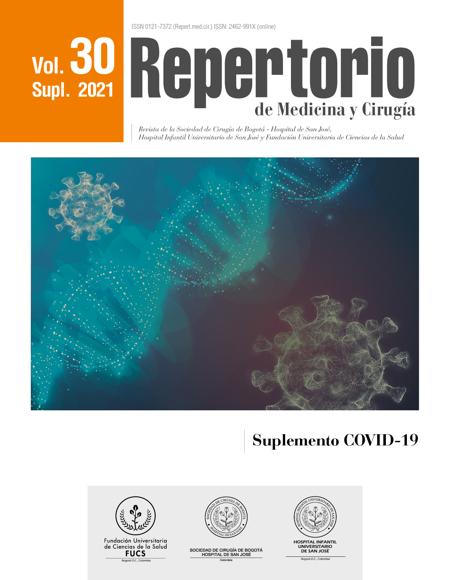COVID-19 in colombia: one year since the first case was confirmed
COVID-19 en Colombia: un año después de confirmar su primer caso
![]()
![]()

Show authors biography
Introduction: coronavirus disease 2019 (COVID-19) is an acute respiratory infectious disease caused by a novel coronavirus. The World Health Organization (WHO) was aware of cases of pneumonia of unknown microbial etiology associated with the city of Wuhan, province of Hubei, China, on December 31 2019. Objective: to present the trend of COVID-19 disease one year after the first positive case was registered in Colombia. Methodology: this research work was carried out using a quantitative approach. Results: the monthly lethality rates for COVID-19 in Colombia were estimated. The highest lethality rate per 100 inhabitants occurred in April 2020 4.71%, in the first place, and in February 2021 3.68%. The highest incidence was reported in the months of January 2021 0.884% and December 2020 0.664%. The highest prevalence, the other epidemiological measure, was reported in early 2021 in the months of: January 4.1%, and February 4.41%. Conclusion: COVID-19 disease lethality, incidence and prevalence in Colombia have had a series of fluctuations since the first case was confirmed in our country. Now, as vaccination has begun, it offers the possibility of reducing contagion and mortality.
Article visits 5890 | PDF visits 1292
Downloads
- BMJ. Enfermedad por coronavirus 2019 (COVID-19). [Internet]. 2020 [ Citado el 13 de enero de 2021]. Recuperado de: https://bestpractice.bmj.com/topics/es-es/3000201
- Zhou P, ZL. SARS-CoV-2 spillover events. Science. 2021;371(6525):120-122. doi: 10.1126/science.abf6097 DOI: https://doi.org/10.1126/science.abf6097
- Li Q, Guan X, Wu P, Wang X, Zhou L, Tong Y, Ren R, et al. Early Transmission Dynamics in Wuhan, China, of Novel Coronavirus-Infected Pneumonia. N Engl J Med. 2020;382(13):1199-1207. doi: 10.1056/NEJMoa2001316 DOI: https://doi.org/10.1056/NEJMoa2001316
- Zhou F, Yu T, Du R, Fan G, Liu Y, Liu, Z. Clinical course and risk factors for mortality of adult inpatients with COVID-19 in Wuhan, China: a retrospective cohort study. Lancet. 2020;395(10229):1054-1062. doi: 10.1016/S0140-6736(20)30566-3 DOI: https://doi.org/10.1016/S0140-6736(20)30566-3
- Guan WJ, Ni ZY, Hu Y, Liang WH, Ou CQ, He JX, et al. Clinical Characteristics of Coronavirus Disease 2019 in China. J Emerg Med. 2020;58(4): 711–712. doi: 10.1016/j.jemermed.2020.04.004 DOI: https://doi.org/10.1016/j.jemermed.2020.04.004
- Fauci, AS, Lane HC, Redfield RR. Covid-19 - Navigating the Uncharted. N Engl J Med. 2020 Mar 26;382(13):1268-1269. doi: 10.1056/NEJMe2002387 DOI: https://doi.org/10.1056/NEJMe2002387
- Kucharski A, Klepac P, Conlan A, Kissler S, Tang M, Fry H, et al. Effectiveness of isolation, testing, contact tracing and physical distancing on reducing transmission of SARS-CoV-2 in different settings. medRxiv. 2020;20(10):P1151-1160 doi: 10.1016/S1473-3099(20)30457-6 DOI: https://doi.org/10.1101/2020.04.23.20077024
- Cooke SJ, Cramp RL, Madliger CL, Bergman JN, Reeve C, Rummer JL, Hultine KR, et al. Conservation physiology and the COVID-19 pandemic. Conserv Physiol. 2021;9(1):coaa139. doi: 10.1093/conphys/coaa139 DOI: https://doi.org/10.1093/conphys/coaa139
- Díaz-Pinzón JE. Uso de modelo predictivo para la dinámica de transmisión del COVID-19 en Colombia. Repert Med Cir. 2020;29(Núm. Supl.1):34-44. doi: 10.31260/RepertMedCir.01217372.1056 DOI: https://doi.org/10.31260/RepertMedCir.01217372.1056
- Moreno-Altamirano A, López-Moreno S, Corcho-Berdugo A. Principales medidas en epidemiología. Revista Cubana de Higiene y Epidemiología. 2007;45(1):337-48. DOI: https://doi.org/10.1590/S0036-36342000000400009
- Quintana-Salgado. L. Medidas de frecuencia en epidemiología [Internet]. 2015 Slideshare; [Citado 25 de julio de 2020]. Disponible en: https://es.slideshare.net/lualberts20/medidas-de-frecuencia-en-epidemiologa-2015
- Pinto, A. Prevalencia e Incidencia [Internet]. Slideshare; 2014. [Citado 21 de julio de 2020]. Disponible en: https://es.slideshare.net/alexpinto18/prevalencia-e-incidencia-2?next_slideshow=2
- Fisterra. Medidas de frecuencia de enfermedad [Internet]. 2004. [Citado 21 de agosto de 2020]. Disponible en: https://www.fisterra.com/formacion/metodologia-investigacion/medidas-frecuencia-enfermedad/
- Díaz-Pinzón, J.E. Correlación y regresión lineal de la evaluación tiempo y puntaje con recurso interactivo flash. INNOVA Research Journal. 2017;2(10):1-8. doi: 10.33890/innova.v2.n10.2017 DOI: https://doi.org/10.33890/innova.v2.n10.2017.254
- Díaz-Pinzón JE. Estudio de los resultados del contagio por COVID-19 a nivel mundial. Repert Med Cir. 2020;29(Núm. Supl.1):65-71. doi: 10.31260/RepertMedCir.01217372.1089 DOI: https://doi.org/10.31260/RepertMedCir.01217372.1089
- Instituto Nacional de Salud. Coronavirus (COVID-2019) en Colombia [Internet]. Bogotá: Instituto Nacional de Salud; 2020. [citado 2021 febrero 28]; Recuperado de: https://www.ins.gov.co/Noticias/Paginas/Coronavirus.aspx
- Departamento Administrativo Nacional de Estadística. DANE. Proyecciones y retroproyecciones de población [Internet]. 2000. [Citado 28 de febrero de 2021]. Disponible en: https://www.dane.gov.co/index.php/estadisticas-por-tema/demografia-y-poblacion/proyecciones-de-poblacion
- Díaz Pinzón JE. Estudio comparativo entre el contagio durante la cuarentena obligada por el COVID-19 y el contagio durante la apertura gradual y controlada para algunos sectores de la economía en Colombia. Repert Med Cir. 2020;29(Supl.Núm.1):59-64. doi: 10.31260/RepertMedCir.01217372.1073 DOI: https://doi.org/10.31260/RepertMedCir.01217372.1073












